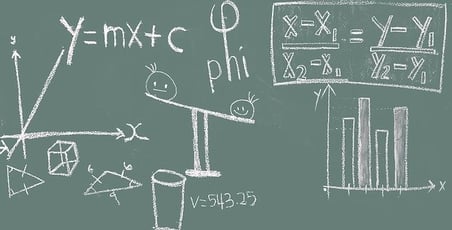how to find the standard deviation of a data set
Standard deviation is a way to calculate how spread out data is. You can use the standard deviation formula to find the average of the averages of multiple sets of data. Confused by what that means? How do you calculate standard deviation? Don't worry! In this article, we'll break down exactly what standard deviation is and how to find standard deviation. Standard deviation is a formula used to calculate the averages of multiple sets of data. Standard deviation is used to see how closely an individual set of data is to the average of multiple sets of data. There are two types of standard deviation that you can calculate: Population standard deviation is when you collect data from all members of a population or set. For population standard deviation, you have a set value from each person in the population. Sample standard deviation is when you calculate data that represents a sample of a large population. In contrast to population standard deviation, sample standard deviation is a statistic. You're only taking samples of a larger population, not using every single value as with population standard deviation. The equations for both types of standard deviation are pretty close to each other, with one key difference: in population standard deviation, the variance is divided by the number of data points $(N)$. In sample standard deviation, it's divided by the number of data points minus one $(N-1)$. Here's how you can find population standard deviation by hand: That's a lot to remember! You can also use a standard deviation formula. The commonly used population standard deviation formula is: $$σ = √{(Σ(x - μ)^2)/N}$$ In this formula: $σ$ is the population standard deviation $Σ$ represents the sum or total from 1 to $N$ (so, if $N = 9$, then $Σ = 8$) $x$ is an individual value $μ$ is the average of the population $N$ is the total number of the population You have collected 10 rocks and measure the length of each in millimeters. Here's your data: $3, 5, 5, 6, 12, 10, 14, 4, 5, 8$ Let's say you're asked to calculate the population standard deviation of the length of the rocks. Here are the steps to solve for that: First, calculate the mean of the data. You'll be finding the average of the data set. $(3 + 5 + 5 + 6 + 12 + 10 + 14 + 4 + 13 + 8) = 80$ $80/10 = 8$ Next, subtraction the average from each data point, then square the result. $(3 - 8)^2 = 25$ $(5 - 8)^2 = 9$ $(5 - 8)^2 = 9$ $(6-8)^2 = 4$ $(12-8)^2 = 16$ $(10-8)^2 = 4$ $(14-8)^2 = 6$ $(4-8)^2 = 4$ $(5-8)^2 = 9$ $(8-8)^2 = 0$ Next, calculate the mean of the squared differences: $25 + 9 + 9 + 4 + 16 + 4 + 6 + 4 + 9 + 0 = 86$ $86/10 = 8.6$ This number is the variance. The variance is $8.6$. To find the population standard deviation, find the square root of the variance. $√(8.6) = 2.93$ You can also solve using the population standard deviation formula: $σ = √{(Σ(x - μ)^2)/N}$ The expression ${(Σ(x - μ)^2)/N}$ is used to represent the population variance. Remember, before we found that the variance is $8.6$. Plugged into the equation you get $σ = √{8.6}$ $σ = 2.93$ Finding sample standard deviation using the standard deviation formula is similar to finding population standard deviation. These are the steps you'll need to take to find sample standard deviation. Let's look at that in practice. Say your data set is $3, 2, 4, 5, 6$. First, calculate your mean: $(3+2+4+5+6) = 20$ $20/5 = 4$ Next, subtract the mean from each of the values and square the result. $(3-4)^2 = 1$ $(2-4)^2 = 4$ $(4-4)^2 = 0$ $(5-4)^2 = 1$ $(6-4)^2 = 2$ Add all the squares together. $1 + 4 + 0 + 1 + 2 = 8$ Subtract one from the number of values you started with. $5-1 = 4$ Divide the sum of all the squares by the number of values minus one. $8 / 4 = 2$ Take the square root of that number. $√2 = 1.41$ The equations for both types of standard deviation are very similar. You might be wondering: When should I use the population standard deviation formula? When should I use the sample standard deviation formula? The answer to that question lies in the size and nature of your data set. If you have a larger, more generalized data set, you'll use sample standard deviation. If you have specific data points from every member of a small data set, you'll use population standard deviation. Here's an example: If you are analyzing the test scores of a class, you'll use population standard deviation. That's because you have every score for every member of the class. If you're analyzing the effects of sugar on obesity from people ages 30 to 45, you'll use sample standard deviation, because your data represents a larger set. Standard deviation is a formula used to calculate the averages of multiple sets of data. There are two standard deviation formulas: the population standard deviation formula and the sample standard deviation formula. Writing a research paper for school but not sure what to write about? Our guide to research paper topics has over 100 topics in ten categories so you can be sure to find the perfect topic for you. Want to brush up on any of your other math topics ahead of the ACT? Check out our individual math guides to get the walk-through on each and every topic on the ACT math test. Running out of time on the ACT math section? Our guide will help you learn how to beat the clock and maximize your ACT math score. Running out of time on the SAT math section? Look no further than our guide to help you beat the clock and maximize your SAT math score.
What Is Standard Deviation?
Standard Deviation Formula: How to Find Standard Deviation (Population)
How to Find Standard Deviation (Population): Sample Problem
#1: Calculate the Mean of the Data
#2: Subtract the Average From Each Data Point, Then Square
#3: Calculate the Mean of Those Squared Differences
#4: Find the Square Root of the Variance

How to Find Sample Standard Deviation Using the Standard Deviation Formula
#1: Calculate Your Mean
#2: Subtract the Mean and Square the Result
#3: Add All the Squares
#4: Subtract One From the Initial Number of Values You Had
#5: Divide the Sum of the Squares by the Number of Values Minus One
#6: Find the Square
When to Use Population Standard Deviation Formula and When to Use Sample Standard Deviation Formula
Summary: How to Find Sample Standard Deviation and Population Standard Deviation
What's Next?

About the Author
Hayley Milliman is a former teacher turned writer who blogs about education, history, and technology. When she was a teacher, Hayley's students regularly scored in the 99th percentile thanks to her passion for making topics digestible and accessible. In addition to her work for PrepScholar, Hayley is the author of Museum Hack's Guide to History's Fiercest Females.
how to find the standard deviation of a data set
Source: https://blog.prepscholar.com/standard-deviation-formula
Posted by: rileypulded.blogspot.com

0 Response to "how to find the standard deviation of a data set"
Post a Comment